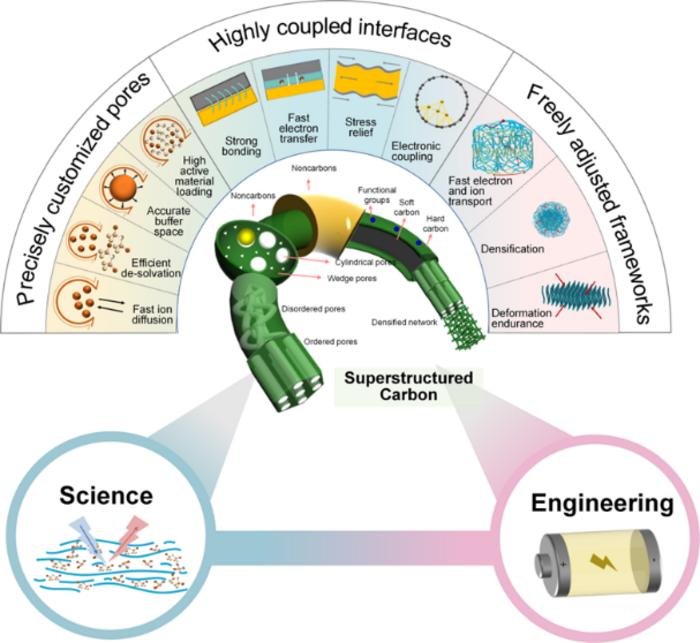There is a lot of study on the topic of switching from carbon to other energy sources, but what if carbon was used to its maximum potential instead?
 Each characteristic displayed is an integral part of ensuring the function of the SCC can be used to improve upon traditional carbon materials used in energy storage and conversion devices. Image Credit: Debin Kong, Tsinghua University
Each characteristic displayed is an integral part of ensuring the function of the SCC can be used to improve upon traditional carbon materials used in energy storage and conversion devices. Image Credit: Debin Kong, Tsinghua University
It is essential to recognize the significance of carbon as an energy source. Unfortunately, the environmental consequences of depending on these carbon-based products have been overwhelming, particularly considering the massive worldwide use of these resources. As a result, different methods need to be investigated.
Superstructure carbons (SCC) have the potential to outperform the existing standard materials in energy storage and conversion devices in terms of performance and endurance, making carbon usage more environmentally friendly and efficient.
On January 30, 2024, researchers published their findings in Energy Materials and Devices.
SCCs are complex in how they are built and perform. The first step is acknowledging that they are carbons. Although this may not be a step toward reducing total carbon reliance, it gives the carbons more direct, intended purposes that could enhance functionality and performance.
This unique category satisfies the particular functional demands of high-performance devices and surpasses the rigid structure of traditional carbons.
Debin Kong, Study Author and Professor, University of Science &Technology Beijing
SSCs are carbon-based materials explicitly designed for the material they interact with, such as a lithium-ion (Li) battery, lithium sulfide (LiS) battery, or a metal-air battery.
Researchers have identified three fundamental properties of these SCCs for effective development and implementation: precisely designed pores, flexibly adjustable frameworks, and highly connected interfaces.
The benefit of adequately designed pores over conventional carbon composites is enhanced mass transfer and surface utilization. In energy-storage devices (such as batteries), adding porous carbon to the active material can enhance metrics like the material's specific capacity. The amount of electrical charge that can be applied to a material per gram of its weight is known as its specific capacity.
Rapid electron transfer between the carbon unit and electrode and between the inner workings of the materials depends on freely adjusting frameworks. Ultimately, electron transmission can be further enhanced via strongly coupled interfaces, a crucial factor in enhancing a battery’s overall performance and functionality.
Interfaces that function well together allow electrochemical processes to occur more quickly and without problems like aggregation or the development of nanoparticle clusters.
Kong added, “Overall, the concept of SSCs shows a way to solve the problems faced by current carbons, which is important to the practical applications of advanced carbons and their relevant high performance energy related devices in future.”
With this review, researchers want to achieve new highs for carbon structures rather than simply improving carbon-based active materials. Performance breakthroughs are the ultimate goal, trying to break past energy conversion and storage bottlenecks. However, there are always challenges to overcome via more research.
The most crucial thing to remember is that each device has distinct requirements. Li, LiS, and metal-air batteries will likely have unique relationships with SCCs that must be adequately explored to assure applicability and compatibility. Furthermore, the cost and performance of SCCs must be evaluated before they become a realistic and ubiquitous option.
This might involve improving the preparation process and precursors required to save costs and streamline manufacturing. Another area that requires more investigation is carbon microstructure and its structural development based on the carbon precursor employed.
Debin Kong, Wei Lv, Yanbing He, and Feiyu Kang of the Shenzhen Giem Graphene Center and Engineering Laboratory for Functionalized Carbon Materials at Tsinghua University with Debin Kong also of the College of New Energy at China University of Petroleum, Ruliang Liu, Dingcai Wu, and Ruowen Fu of the Materials Science Institute at Sun Yat-sen University, Feng Li of the Shenyang National Laboratory for Materials Science at the Chinese Academy of Sciences and Quan-Hong Yang of the Nanoyang Group at the School of Chemical Engineering and Technology at Tianjin University all contributed to this study.
The study was made possible by the National Nature Science Foundation of China, the National Basic Research Program of China, and the Taishan Scholar Project of Shandong Province.
Journal Reference:
Kong, D., et. al. (2024) Superstructured carbon materials: design and energy applications. Energy Materials and Devices. doi:10.26599/EMD.2023.9370017